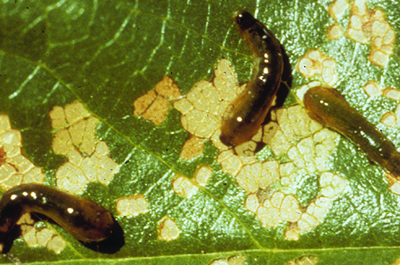Slug sawflies
July 31, 2015
Roseslug, Endelomyia aethiops
Bristly roseslug, Cladius difformus
Pear sawfly, Caliroa cerasi
The adults of all slug sawflies are small and wasp-like. Adult females lay eggs in the leaf, and larvae skeletonize the leaves after they hatch and begin to feed. Roseslug sawflies feed solely on roses. Leaves are skeletonized along the upper and lower leaf surfaces, leaving only the veins and causing the leaf surfaces to turn brown.

Roseslug injury.
Look for larvae beginning in May through the end of June. There is one generation per year. Larvae are bright green with orange head capsules. Mature larvae are 19 mm. The bristly roseslug, (not shown) is covered with bristle-like hairs and chews holes in the leaves as it matures. It has 5 to 6 generations per year. Pearslug sawflies have a wider host range, including pear (not Bradford pear) crabapple, mountain ash, cherry, cotoneaster, amelanchier, and hawthorn.

Roseslug larva.
Pearslugs are dark olive green, slimy, and swollen at the head end. They overwinter in the ground as full-grown larvae, pupate and emerge as adults around late May to early June. Larvae feed in a group for about 3 to 4 weeks and may cause considerable leaf damage.
Management
Little is known about natural enemies. Dislodge larvae with a strong jet of water. Insecticidal soaps may be effective, but be sure to check the label for phytotoxicity to host plants. There are several insecticides labeled for use on slug sawflies; Bt. is not effective on sawflies.

Pearslug larvae have characteristic window feeding.
Print a PDF of this page: Slug sawflies



 Print
Print Email
Email



